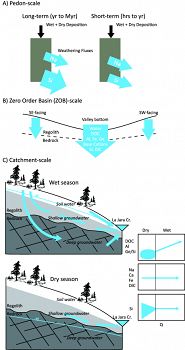McIntosh
Geochemical evolution of the Critical Zone across variable time scales informs concentration-discharge relationships: Jemez River Basin Critical Zone Observatory
McIntosh J.C., Schaumberg C., Perdrial J., Harpold A., Vázquez-Ortega A., Rasmussen C., Vinson D., Zapata-Rios X., Brooks P.D., Meixner T., Pelletier J., Derry L., Chorover J. (2017)
Water Resources Research 53(5): 4169–4196 Cross-CZO National
-
Catalina-Jemez, INVESTIGATOR
-
Catalina-Jemez, Luquillo, Reynolds, INVESTIGATOR
-
Boulder, Catalina-Jemez, INVESTIGATOR
-
Catalina-Jemez, GRAD STUDENT
-
Catalina-Jemez, INVESTIGATOR
-
Catalina-Jemez, GRAD STUDENT
-
Catalina-Jemez, INVESTIGATOR
-
Catalina-Jemez, INVESTIGATOR
-
Catalina-Jemez, INVESTIGATOR
-
National, Shale Hills, INVESTIGATOR, COLLABORATOR
-
Catalina-Jemez, INVESTIGATOR
Abstract
Conceptual model of CZ development, flow paths, and solute fluxes controlling C/Q relationships across temporal and spatial scales.
This study investigates the influence of water, carbon, and energy fluxes on solute production and transport through the Jemez Critical Zone (CZ) and impacts on C-Q relationships over variable spatial and temporal scales. Chemical depletion-enrichment profiles of soils, combined with regolith thickness and groundwater data indicate the importance to stream hydrochemistry of incongruent dissolution of silicate minerals during deep bedrock weathering, which is primarily limited by water fluxes, in this highly fractured, young volcanic terrain. Under high flow conditions (e.g., spring snowmelt), wetting of soil and regolith surfaces and presence of organic acids promote mineral dissolution and provide a constant supply of base cations, Si, and DIC to soil water and groundwater. Mixing of waters from different hydrochemical reservoirs in the near stream environment during “wet” periods leads to the chemostatic behavior of DIC, base cations, and Si in stream flow. Metals transported by organic matter complexation (i.e., Ge, Al) and/or colloids (i.e., Al) during periods of soil saturation and lateral connectivity to the stream display a positive relationship with Q. Variable Si-Q relationships, under all but the highest flow conditions, can be explained by nonconservative transport and precipitation of clay minerals, which influences long versus short-term Si weathering fluxes. By combining measurements of the CZ obtained across different spatial and temporal scales, we were able to constrain weathering processes in different hydrological reservoirs that may be flushed to the stream during hydrologic events, thereby informing C-Q relationships.
Citation
McIntosh J.C., Schaumberg C., Perdrial J., Harpold A., Vázquez-Ortega A., Rasmussen C., Vinson D., Zapata-Rios X., Brooks P.D., Meixner T., Pelletier J., Derry L., Chorover J. (2017): Geochemical evolution of the Critical Zone across variable time scales informs concentration-discharge relationships: Jemez River Basin Critical Zone Observatory. Water Resources Research 53(5): 4169–4196 . DOI: 10.1002/2016WR019712
 This Paper/Book acknowledges NSF CZO grant support.
This Paper/Book acknowledges NSF CZO grant support.
Explore Further












